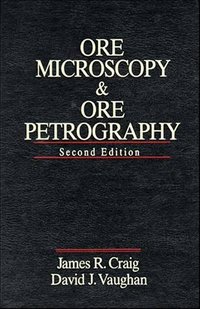
Open Access Publications

Ore microscopy and ore petrography - 2nd ed.
James R. Craig and David J. Vaughan
i-xiv + 434 pages. ISBN 0-471-55175-9
Description
Table of Contents with links free downloads to the entire book, or individual full-text parts, chapters, or Appendices.
Description
The study of opaque minerals or synthetic solids in polished section using the
polarizing reflected-light microscope is the most important technique for the
identification and characterization of the opaque phases in a sample and the
textural relationships between them. Since most metalliferous ores are comprised
of opaque minerals, this study has been traditionally known as ore microscopy
and has found its greatest applications in the study of mineral
deposits. It may be applied, however, as a general technique in the study of
igneous, sedimentary, or metamorphic rocks containing opaque minerals and
even in the study of metallurgical products or other synthetic materials.
The objective of this text is to present an up-to-date introduction to ore microscopy
for the student or professional scientist who is unfamiliar with the
technique-an introduction that would accompany a course at the senior
undergraduate or graduate level or that would provide the professional with a
first step in familiarization. No attempt has been made at a comprehensive
treatment of the subject; for this the reader is referred to the excellent works of
such authors as Rarndohr, Uytenbogaart and Burke, Galopin and Henry cited
in relevant sections ofthis text. Emphasis is placed on the basic skills required
for the study of opaque minerals in polished section, and information in the
text and appendices on the more common ore minerals and assemblages provides
examples.
The first two chapters cover the design and operation of the ore microscope
and the preparation of polished (and polished thin) sections. A chapter dealing
with qualitative mineral properties used in identification is followed by a
discussion of reflected-light optics. The quantitative measurement of reflectance,
color, and microhardness are treated in Chapters 5 and 6 along with
overall schemes for employing these measurements in identification. Chapters 7 and 8 deal with ore mineral textures and paragenesis, and include a brief
discussion of the study of fluid inclusions. Chapters 9 and 10 are concise discussions
of many of the major ore mineral associations observed under the
microscope. These discussions are not intended to be exhaustive, especially
with regard to comments made on the genesis of the ores, but are designed to
aid understanding by placing the ore mineral textures and associations in a
broader geological context. Chapter 11 deals with the applications of ore microscopy
in mineral technology. The appendices contain the data necessary to
identify approximately 100 of the more common ore minerals-those likely to
be encountered by the student in an introductory course andthose frequently
encountered by the professional scientist. Key references to more detailed
accounts are provided throughout the text. The dependence ofthe properties,
textures, and associations of the minerals on their crystal chemistry, thermochemistry,
and phase relations is an aspect of modern studies of ore
minerals that is particularly emphasized.
This second edition retains the overall structure of the first edition. Chapters
1and 2, dealing with the ore microscope and with the preparation of samples
for ore microscopy, have been updated and revised to take account of
technical developments. Chapters 3 and 4 deal with qualitative methods of
mineral identification and with reflected light optics, and remain largely
unchanged. Chapters 5 and 6 deal with quantitative methods in reflected-light
microscopy and have been revised to include new technical developments
and advances in theory. Chapters 7 and 8, dealing with ore mineral textures,
paragenesis, formation conditions, and fluid inclusions, incorporate new data
and examples. Chapters 9 and 10, which cover the most important examples of
ore mineral assemblages, have been rewritten so as to incorporate many new
references to original studies that have been performed in the years since the
publication of the first edition. Developments have also taken place in the
applications of ore microscopy in mineral technology and in the study of both
the products of milling and concentration of ores,and the synthetic analogs of
minerals that occur in metallurgical, corrosion, and waste products.
As in the first edition, an important feature of this text is the incorporation
of appendices detailing and tabulating the diagnostic properties of about 100
ofthe most common ore minerals. These data tabulations have been updated
using the most recently available quantitative data. Another appendix, which
briefly describes ancillary techniques for the study of ore minerals, has been
extended to include the most recent innovations.
James R. Craig, Blacksburg, Virginia
David J. Vaughan, Manchester, England
November 1994
Ore microscopy and ore petrography - 2nd ed.
The entire volume as a single, compressed pdf file.
The textbook by individual parts, chapters, or Appendices.
Front Matter (Title Page, Copyright Contents)
Download (655 KB)
Chapter 1. The Ore Microscope.
Download (2.3 MB)
Chapter 2. The Preparation of Samples for Ore Microscopy.
Download (3.3 MB)
Chapter 3. Mineral Identification - Qualitative Methods.
Download (2.7 MB)
Chapter 4. Reflected Light Optics.
Download (4.0 MB)
Chapter 5. Quantitative Methods - Reflectance Measurements.
Download (6.2 MB)
Chapter 6. Quantitative Methods - Microindentation Hardness.
Download (2.2 MB)
Chapter 7. Ore Mineral Textures.
Download (21.7 MB)
Chapter 8. Paragenesis, Formation Conditions, and Fluid Inclusion Geothermometry of Ores.
Download (13.3 MB)
Chapter 9. Ore Mineral Assemblages Occurring in Igneous Rocks and Vein Deposits.
Download (8.5 MB)
Chapter 10. Ore Mineral Assemblages Occurring in Sedimentary, Volcanic, Metamorphic, and Extraterrestrial Environments
Download (17.6 MB)
Chapter 11. Applications of Ore Microscopy in Mineral Technology.
Download (10.2 MB)
Appendix 1. Table of Diagnostic Properties of the Common Ore Minerals
Download (12.7 MB)
Appendix 2. Characteristics of Common Ore Minerals
Download (1.4 MB)
Appendix 3. Ancillary Techniques
Download (2.7 MB)
Author/Subject Index
Download (1.3 MB)

